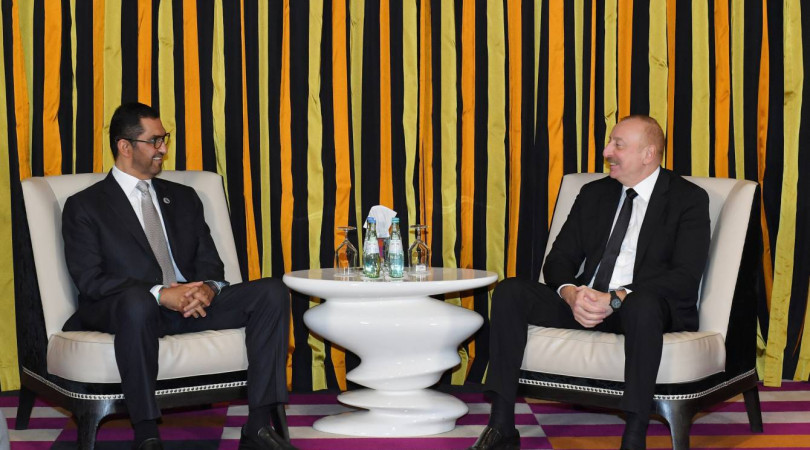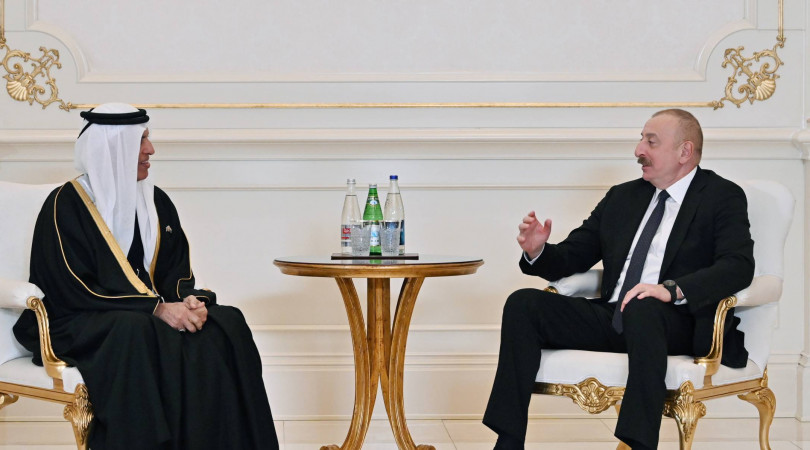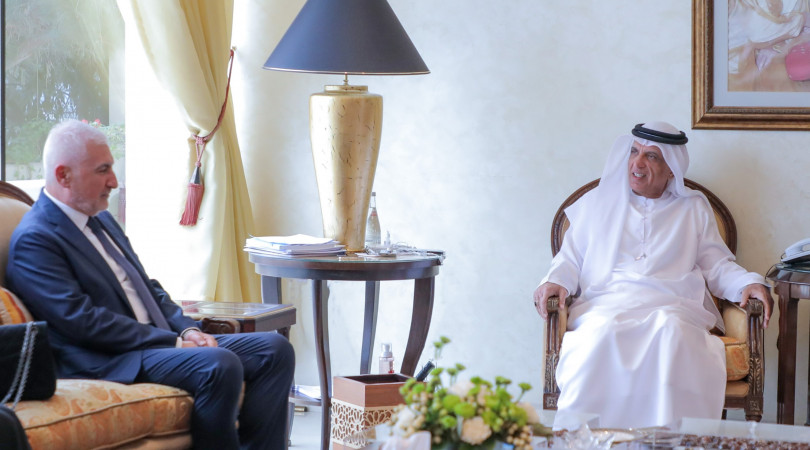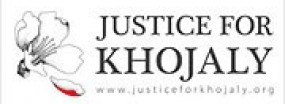A luxury guide to Baku, Azerbaijan Azerbaijan's capital, a new Etihad route, mixes history with a strikingly modern skyline
A luxury guide to Baku, Azerbaijan
Azerbaijan's capital, a new Etihad route, mixes history with a strikingly modern skyline
A view along Baku's waterfront, with the Flame Towers and TV tower in the distance. Getty Images
Why Baku?
An engaging blend of Dubai, Paris, Marrakech and Moscow, Baku, now just a two-and-a-half-hour flight from Abu Dhabi, makes for an excellent luxury weekend break, especially after the recent relaxation of visa restrictions (apply online via https://evisa.com.az/en/).
Once a meeting point on the Silk Road, today, modern architecture, including the Flame Towers and Zaha Hadid’s superlative Heydar Aliyev Cultural Centre, is juxtaposed with a Unesco-listed old town ringed by original, though restored, city walls and many interesting buildings.
Walking in Baku's old town. Rosemary Behan
The city boasts dozens of museums, from the general to eccentric and historic to cutting-edge, and its geographical location on a peninsula jutting into the Caspian Sea, the world’s largest lake, is as spectacular as it is unusual. Travelling from the Gulf, the comparisons in terms of the importance of oil and gas, its Islamic heritage and halal food, not to mention its strategic position, give it additional relevance. In summer, its climate and beaches have obvious appeal.
Mostly walkable, safe and with low-cost taxis and high-end accommodation, shopping and dining – probably the finest in the Caucasus region – make it both interesting and easy. Caspian Waterfront, a striking new entertainment centre and mall on the Bulvar and shaped like a flower, is set to open this year.
Spend four nights in the city to visit fascinating sites on the nearby Absheron Peninsula. These include the beautiful Fire Temple at Suraxanı, which was originally built by Zoroastrians though the current structure dates from the 18th century, and Fire Mountain (also known as Yanar Dag), one of the few remaining natural gas fires that burns continuously thanks to the steady seepage of gas from just beneath the surface of the earth.
The Fire Temple at Suraxani. Rosemary Behan
There's also Pir Hasan, a site where superstitous locals break bottles to cure them of nervousness, the Mir Movsum Ziyaritagah shrine, with a glittering mirrored interior, and the impressive Mardakan Castle, dating from 1225.
The Mir Movsom Ziyaritagah shrine on the Absheron Peninsula. Rosemary Behan
A comfortable bed
The best hotel in town is the Four Seasons Baku, which enjoys a prime position, sandwiched between the waterfront and the old city. The neoclassical building has 171 rooms and feels palatial without being gaudy. Rooms cost from 593 Azerbaijani manats (Dh1,291) per night, including taxes.
Four Seasons Hotel Baku. Courtesy Four Seasons Hotel Baku
Up on the hill with more of an overview of the city, the spectacular Flame Towers are home to the Fairmont Baku, which is 28 storeys high and contains 300 rooms. Rooms here cost from 305 manats (Dh664) per night, including taxes.
Find your feet
The Lonely Planet guide to Georgia, Armenia and Azerbaijan features a good four-kilometre, three-hour self-guided walking tour that takes you from the Maiden’s Tower, a 29-metre high, 12th-century structure facing the waterfront – it’s worth paying the entrance fee to climb up to the top for a good overview of the city.
The Maiden's Tower in Baku's old town. Rosemary Behan
Carry on north through the backstreets of the old city, ticking off mosques, old hammams, the city walls, cafes and the worthwhile Palace of the Shirvanshahs, before a stop at the free Museum of Miniature Books. Inside is a collection of tiny Qurans, each only a couple of centimetres wide.
One of a collection of miniature Qurans in Baku, Azerbaijan. Rosemary Behan
Survey the French-style architecture east of the old city on your way to Fountains Square, the city’s main gathering place, before tracking west to take the funicular up to Sahidlar Xiyabani, a cemetery, memorial and viewpoint opposite the Flame Towers.
Meet the locals
Stroll along the Bulvar, a handsome promenade dating from 1909 that runs for several kilometres. The architecture is from when the city was a gathering place for the world’s oil barons, and the wealth that followed. Strolling families, courting couples, joggers, cyclists and chess players mean that it’s well used.
Baku's Bulvar, or promenade. Rosemary Behan
Book a table
Dining doesn’t get more authentic than a room in a 16th-century caravanserai in the old city. Karvansaray is split into two parts, a tea house and restaurant. On both sides, you can sit inside one of the original small rooms set around a courtyard, where travellers and merchants on the Silk Road would rest while they marketed their goods. The rooms’ fireplaces are gas-lit and hugely atmospheric. A simple but delicious dushbara or arista meat soup, the first with tiny dumplings and the second with noodles, in a delicious hot broth, costs 4 manats (Dh9). The pumpkin kutub, or stuffed pancakes (1.50 manats [Dh3]), are also worth trying, along with the delicious, perfectly stone-baked tandir bread.
Traditional soups at Karavansaray in Baku's old town. Rosemary Behan
For those who prefer to eat local food in a less traditional setting, Firuza on Fountains Square is also recommended for value.
Between Fountains Square and the Bulvar, Paris Bistro has an attractive location on a square and offers French classics at mid-range prices. Nearby, sushi fans should head to the upmarket Zakura, which offers quality dishes such as crispy gyoza, tuna sashimi salad and Tokyo rolls from 6 manats (Dh13). From the same management with similar prices is the similarly excellent pan-Asian Chinar.
The area next to Port Baku Mall features a selection of slick, quality restaurants, including Harbour, a seafood restaurant; a branch of Movida; Masu, a Japanese restaurant; and Scalini, an Italian fine dining restaurant. See portbaku-dining.az for more details.
Shopper’s paradise
The pedestrianised Nizami Kucasi, which runs south from Fountains Square to the Bulvar, is a European-style shopping street. The Bulvar and streets running off it offer outlets of most of the world’s luxury brands, including Bulgari, Dior, Dolce & Gabbana and Tiffany. If you prefer a mall, there are plenty to choose from, though the three-storey, 32,000-square-metre Port Baku Mall is the only solely luxury option.
In the old city and city centre, traditional copperware, Azerbaijani teas (Azeri chai) and their signature curved glass Armudu teacups are popular buys (crystal ones will set you back from 20 manats [Dh44] each), along with sweets, silk scarves and rugs.
Caviar is also a third of the price you would pay in Europe, at about 120 manats (Dh261) for a 113-gram pot.
What to avoid
This year’s Azerbaijan Grand Prix takes place on April 29, so unless you like Formula One, avoid this whole week – the best hotels will be busier and more expensive, and the city will be harder to get around, with the streets defaced by concrete blocks and tall wire fencing.
Don’t take photographs of official buildings or jaywalk.
Don’t miss
Make the effort to get out to the 57,000-square-metre Heydar Aliyev Cultural Centre, which was deliberately built without any straight lines and is a visual feast from every angle. There’s a surprising amount to see inside, too, from archaeological finds and ancient manuscripts to an impressive collection of post-1960s fashion and contemporary art. The centre’s cafe-restaurant is also beautiful; standard tickets 15 manats (Dh32).
Heydar Aliyev Center, a building designed by architect Zaha Hadid in Baku. Photo by Rosemary Behan
Getting there
Etihad flies direct to Baku three times a week. Tickets cost from Dh1,250 return, including taxes.
Getting around
One-day guided tours of Baku’s old city cost from US$98 (Dh360) per person, and tours of the Absheron Peninsula cost from $118 (Dh433) through Voyage Tours Azerbaijan.
https://www.thenational.ae/lifestyle/travel/a-luxury-guide-to-baku-azerbaijan-1.716844





.png)












